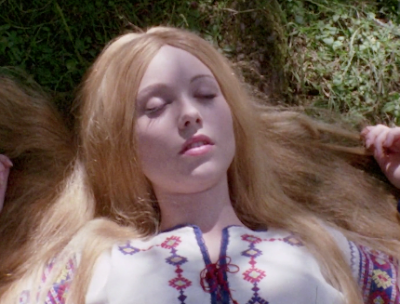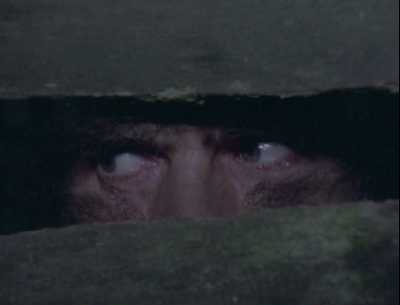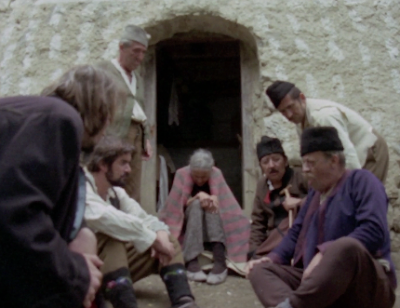Folk horror has seen a renewed interest in recent years with the mainstream success of movies like Ari Aster's Midsommar (2019); enough so that director Kier-La Janisse has recently produced a three-and-a-quarter hour documentary on the subject, titled Woodlands Dark and Days Bewitched: A History Of Folk Horror (2021) and Severin Films has announced a whopping 12 disc blu-ray box set, titled "All The Haunts Be Ours: A Compendium Of Folk Horror", which features this post's feature title, among several others. Of course the concept of folk horror isn't a new one, if anything it's one of the oldest and firmest foundational supports of the horror and dark fantasy genres. The rustic horrors of the Brothers Grimm and other cultural fairy tales from around the globe aren't products of the dangers of metropolitan environs, but built on the terror and anxieties about what might be hiding out in the woods; the parts where the sun doesn't permeate the canopy, and where there aren't people around to hear you scream. Vampires, werewolves and old crones with the power to curse didn't start out haunting the dark alleys and derelict quarters of big cities until relatively recently; they are the products of the shadow-strewn ruins of time-tattered graveyards, abandoned abbeys and vacant castles in rural countrysides. It birthed Irving's Headless Horseman, has done wonders for Stephen King's bank account and makes us all a little leery about camping alone in the dark.
 |
| Radojka played by Mijana Nikolic. |
And while the term folk horror, in terms of cinema, generally brings to mind the obvious British fare from the 1960s and 70s, like The Wicker Man (Robin Hardy, 1973), Cry Of The Banshee (Gordon Hessler, 1970) and Witchfinder General (Michael Reeves, 1968), we'd be remiss to credit the debt that the fear of the rural plays into films like The Texas Chainsaw Massacre (Tobe Hooper, 1974), Deliverance (John Boorman, 1972), the cultural phenomenon The Blair Witch Project (Daniel Myrick and Eduardo Sánchez, 1999) and, dare I even say Sam Peckinpah's Straw Dogs (1971).
 |
| The fourth miller to meet the same fate–having his throat torn out by some evil creature haunting the mill. |
Leptirica is the Serbian word for moth, if internet translating services are worth their coding, which makes more sense than the "butterfly" translation that pops up in the subtitles on the crisp print I recently saw. Though one of our protagonists is endearingly referred to as a butterfly at one point in the film, it's a moth that plays a significant part in the end. The film is a 1973 Yugoslavian made-for-television movie with a running time of about 64 minutes, though it seems much longer. This isn't a gripe, but an observation. On one hand, we have the age old story of two young lovers prevented from being together by a domineering guardian. Or so it seems. On the other hand we have a supernatural tale about an evil spirit terrorizing a watermill in a small Yugoslavian village, and the sometimes comical attempts of a group of superstitious peasants to destroy it.
 |
| The eyes of the creature preface each attack on the mill. |
Our two young lovers are young village man Strahinja (Petar Bozovic), and the beautiful Radojka (Mirjana Nikolic), raised by gruff, isolating landowner Zivan (Slobodan Perovic). We learn throughout the film that the young girl isn't Zivan's daughter, and reading between the lines, one is lead to believe that perhaps the two aren't even related, but that Zivan is watching over the girl for some other reason. Zivan does his best to keep Radojka in site at all times and cautions her against becoming involved with Strahinja. At one point Strahinja corners Zivan and asks for Radojka's hand in marriage, which Zivan immediately dismisses, siting Strahinja's lack of means, ambition and prospects for a happy future as cause. Heartbroken, Strahinja vows to leave the village and start a new, potentially fruitful life elsewhere. Meanwhile, the small village is struggling to come to terms with a string of violent deaths. Four successive millers working the watermill where the village grinds its flour have been brutally attacked. The men are worried that they'll starve without someone to guard the mill and keep it in operation, and there's also the fear that the killings are the work of a supposed vampire named Sava Savanovic, who terrorized the region a century back and was buried in some unknown location in the area. Savanovic appears to be as popular to Serbian folklore and popular culture as Count Dracula is to Eastern culture, as two Serbian villages have recently adopted Savanovic as a Mickey Mouse-esque mascot and the historic mill that he allegedly haunted has been rebuilt as a tourist destination. The film itself is loosely based on a short story titled "Ninety Years Later" by Milovan Glisic, and incorporates the legend into its premise.
 |
| Radojka and Strahinja |
Anyhow, with no prospects, the men of the village convince heartbroken Strahinja to take up the position of miller. He presumes that the employment will gain him some higher regard in Zivan's eyes. His first night on the job, he is attacked by the fanged, hairy-faced creature that had done in the previous millers. The difference in the attack on Strahinja, of course, is that he's left alive. Convinced that the evil Sava Savanovic is to blame, the men of the village attempt to locate his grave, dig it up and drive a stake through his heart to end his reign of terror. After they succeed in doing so, the men, emboldened by their success, help Strahinja whisk Radojka away from Zivan's property and arrange a marriage in the village. Things sour when Strahinja sneaks into his fiancee's room the night before their wedding, and finds that Radojka may be more than just a beautiful woman.
 |
| The men of the village consult a very deaf old woman about the legend and burial place of Sava Savanovic. |
Without giving it all away, the two young lovers do eventually end up with each other, though not in the way that they or the viewer may have anticipated. As stated before, the form certainly seems to mirror the content as the mundanity and boredom of the small village's pastoral existence is certainly captured in the pace of the proceedings, but when the not-so-shocking turn of events that most will likely see coming, happens, the pace picks up considerably throughout the final moments. There's a turning point in the film, right after Zivan rejects Strahinja's bid for Radojka's hand in marriage. Strahinja's only reason for sticking around the small village seems to be Radojka's affections; he initially seems to eschew the superstitious, inebriated existence of the other men. When his heart is broken, however, he slowly becomes one of them, discarding his plans to leave and find purpose elsewhere, working the mill, liberally imbibing, and joining the hunt for the mythical vampire. We know at that point that Strahinja would never be leaving the village, alive or otherwise.
 |
| The teeth of the beast. |
The creature itself is seen semi-obscured, either as a pair of searching eyes in a hairy face peering between boards in the mill, prior to an attack, or as a hairy face with a mouth full of sharp fangs, partially covered by a large hood. It definitely resembles a werewolf more than what we might think of as a traditional vampire. There also seems to be a connection between the presence of the creature and the trilling of an unseen bird, which, if you watch closely, also supplies a giveaway to the identity of the creature. The soundtrack to the film is sparse, comprised of the jarring bird noises and the occasional overlay of some folk chanting in the background in key moments, which definitely heightens the proceedings.
It's not going to be everyone's cup of rajika, but if you can find a nice clean print of Leptirica, it might be worth your time. Particularly if you're a fan of folk horror, Eastern European film, or just want to experience something different from your standard 70s horror fare. The film is beautifully shot and provides a window into a culture that has very little representation in our more familiar horror material outside of the torch bearing villagers storming various castles or populating soundstage taverns to warn outsiders about visiting said same locations.
Dir. - Dorde Kadijevic; Screenplay - Dorde Kadijevic; Story by Milovan Glisic; Cinematography - Branko Ivatovic; Editor - Neva Paskulovic-Habic; Music - Milan Trickovic.
Starring: Radojka - Mirjana Nikolic, Strahinja - Petar Bozovic, Zivan - Slobodan Perovic, Kmet - Vasja Stankovic.


Comments
Post a Comment